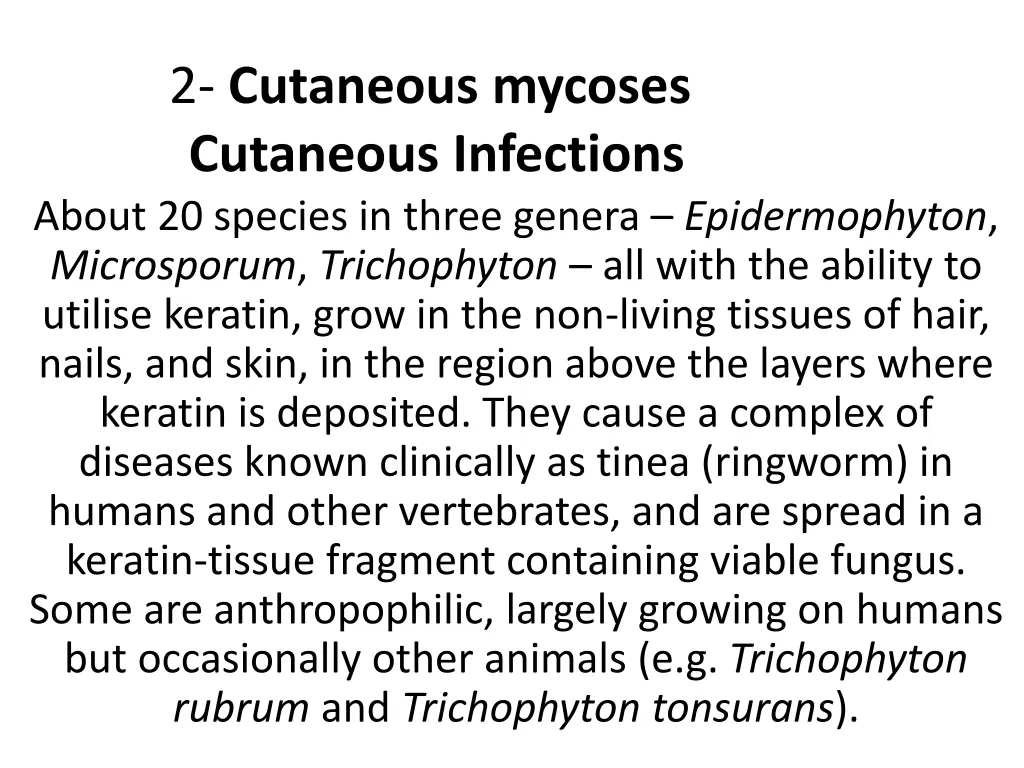
Understanding Cutaneous and Subcutaneous Mycoses
Learn about the different types of fungal infections affecting the skin, hair, and nails, such as dermatophytosis caused by Epidermophyton, Microsporum, and Trichophyton, as well as subcutaneous mycoses like chromoblastomycosis, mycetoma, and sporotrichosis. Explore the clinical significance of Trichophyton fungi and how these pathogens interact with the human body.
Download Presentation

Please find below an Image/Link to download the presentation.
The content on the website is provided AS IS for your information and personal use only. It may not be sold, licensed, or shared on other websites without obtaining consent from the author. If you encounter any issues during the download, it is possible that the publisher has removed the file from their server.
You are allowed to download the files provided on this website for personal or commercial use, subject to the condition that they are used lawfully. All files are the property of their respective owners.
The content on the website is provided AS IS for your information and personal use only. It may not be sold, licensed, or shared on other websites without obtaining consent from the author.
E N D
Presentation Transcript
2- Cutaneous mycoses Cutaneous Infections About 20 species in three genera Epidermophyton, Microsporum, Trichophyton all with the ability to utilise keratin, grow in the non-living tissues of hair, nails, and skin, in the region above the layers where keratin is deposited. They cause a complex of diseases known clinically as tinea (ringworm) in humans and other vertebrates, and are spread in a keratin-tissue fragment containing viable fungus. Some are anthropophilic, largely growing on humans but occasionally other animals (e.g. Trichophyton rubrum and Trichophyton tonsurans).
3-Subcutaneous mycoses Subcutaneous mycoses are common in tropical and subtropical regions of the world. These infections have multiple features in common, including similar epidemiology, mode of transmission, indolent chronic presentation with low potential for dissemination in immunocompetent hosts, and pyogranulomatous lesions on histopathology. Herein, we provide up-to-date epidemiologic, clinical, diagnostic, and therapeutic data for three important subcutaneous mycoses: chromoblastomycosis, mycetoma, and sporotrichosis. These involve the deeper layers of the skin (the dermis, subcutaneous tissue and even bone).
Trichophyton is a genus of fungi, which includes the parasitic varieties that cause tinea, including athlete's foot, ringworm, jock itch, and similar infections of the nail, beard, skin and scalp. Trichophyton fungi are molds characterized by the development of both smooth-walled macro- and microconidia. Macroconidia are mostly borne laterally directly on the hyphae or on short pedicels, and are thin- or thick-walled, clavate to fusiform, and range from 4 to 8 by 8 to 50 m in size. Macroconidia are few or absent in many species.
Pathogenicity and Clinical Significance E. floccosum is one of the common causes of dermatophytosis in otherwise healthy individuals. It infects skin (tinea corporis, tinea cruris, tinea pedis) and nails (onychomycosis). The infection is restricted to the nonliving cornified ) the fungus lacks the ability to penetrate the viable tissues of the immunocompetent host Disseminated infections due to any of the dermatophytes are very unlikely due to the restriction of the infection to keratinized tissues. However, invasive E. floccosum infection has been reported in an immunocompromised patient with Behcet s syndrome ( layers of epidermis since
Important Notes Dermatophytes are fungi that infect skin, hair, and nails and are able to obtain nutrients from keratin, which is abundant in these tissues. include Microsporum, Epidermophyton,and Trichophyton. De rmatophytes usually do not invade into living tissue but rather live only on the outer layers of skin. Fungal systemic infections can be difficult to diagnose because they can bacterial infections; as a result, drugs targeting bacteria are started and the infection persists. Delayed therapy is not uncommon with these types of infections and is particularly true with pneumonia. Fungal systemic infections are more common in patients with a weakened immune system, including patients with acquired immunodeficiency syndrome (AIDS) and patients on immunosuppression.
